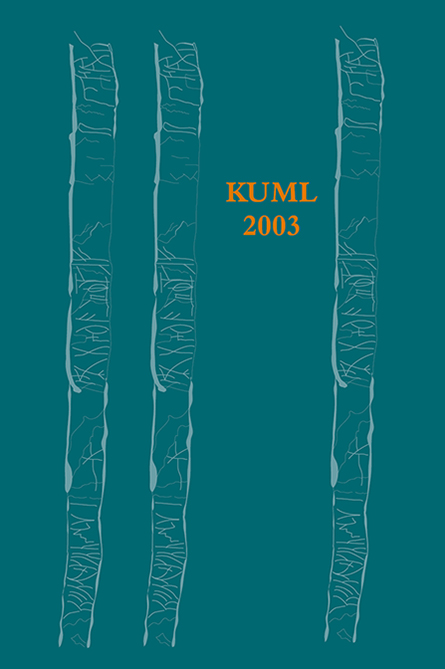Høje, landskab og bosættelse – Rekognosceringer ved Tobøl-Plougstrup-højgruppen
DOI:
https://doi.org/10.7146/kuml.v52i52.102642Keywords:
høje, landskab, bosættelse, rekognoscering, Tobøl-Plougstrup-højgruppenAbstract
Barrows, Landscape and SettlementField surveys at the Tobøl-Plougstrup barrow group
A group of barrows located between the villages of Tobøl and Plougstrup in the parishes of Føvling and Jernved in Ribe County has on several occasions been the object of intense archaeological interest. The group consists of 26 burial mounds all situated close to or in some cases almost directly on the eroded banks of the Kongeå river meadows (fig. 1). Extraordinarily lavish grave goods together with conspicuously large mounds have contributed to an impression of an area of special significance in prehistory. It is, however, the recovery of well-preserved oak log coffins from the Early Bronze Age in three different mounds, which in particular has drawn attention to the locality. The coffins were in every case uncovered under adverse circumstances leaving only scattered information on find circumstances and grave goods.
As part of a larger research program the Tobøl-Plougstrup area was revisited in 1999 where a number of drillings were carried out in selected mounds. The aim was to obtain knowledge on prehistoric soil development, principles of barrow construction and preservation of organic matter in the mounds. In the core of several mounds the presence of an iron pan encapsulation was detected. These iron pans facilitate the preservation of organic matter and have been observed in connection with almost all discoveries of oak log coffins. Recent investigations suggest that the iron pans have developed because of special constructionmethods. This has added to the impression of the special role of the barrow group. In the period 2002-2004 the five metre-high Skelhøj mound will be excavated. With an iron pan encapsulated core the excavation opens the possibility of improved insights into a variety of aspects of Early Bronze Age society. Furthermore, soil analyses of sod material from the other mounds throw light on long-term cultural exploitation of the areas in the vicinity of the individual mounds.
Existing information on Late Neolithic and Early Bronze Age finds suggests that settlement was restricted to the southern side of the Kongeåen, opposite the mounds (fig. 1). This leaves an impression of a secluded ritual landscape on the northern banks of the river.
Focusing on the overall role of mound building and its effect on the development of settlement and landscape it was decided to carry out a systematic field survey of the area. The applied survey strategy had to enable studies of both regular occupation sites and patterns of “off-site” land use. Based on this demand and a wish to preserve the compatibility of the collected material it was decided to apply a strategy of adaptive cluster sampling.
Adaptive cluster sampling is a recently developed statistical sampling procedure intended for clustered populations. It is based upon an initial randomised or systematic distribution of sample units in a regular grid. If a predetermined critical value is exceeded in a unit, its neighbouring units are also sampled (fig. 2). The method in this way focuses on the relatively most informative clusters of the material without losing the statistical properties. This makes it well suited for archaeological field surveying.
In practice, the sampling at Tobøl-Plougstrup started out with a systematic grid of 20x20 m squares in which every 9th square was initially subjected to a 20 min. single person survey. The total sample area covers five square kilometres (fig. 3). It was decided to collect all artefacts, estimated to be more than 200 years old. If a square exceeded a critical value of artefacts four of the adjacent squares were surveyed. The method proved very effective for sampling and delimiting, even in connection with small concentrations of cultural remains (fig. 4). Information on all collected material is contained in a digital database (fig. 5 gives a schematic description of the database in Danish).
The survey is still preliminary and the results should be treated accordingly. However, some overall tendencies are observed. The distribution of four chronologically significant categories of ceramics reveals tempo-spatial patterning (fig. 6). Flint of good quality is very scarce in the area, which is reflected in several aspects of the flint assemblage, for instance the size and exploitation of the cores (fig 7). As regards the production of larger tools like thin-butted flint axes, only the last stages of reduction are present suggesting that these implements entered the area almost completed (fig. 8). The distribution of formal flint tools is to a large extent in accordance with the distribution of ceramics. Two early/ Neolithic/early middle Neolitihic concentrations on the southern side of the Kongeå stand out in particular (fig. 9). Bifacial tools from Late Neolithic and Early Bronze Age are found primarily at three different locations. In the central part of the barrow group, between two concentrations of barrows, some scattered finds of bifacial tools are present (fig. 10). This distribution of finds is compared to the evidence of prehistoric soil development as attested by the drillings in the mounds. Based on this comparison a zoning of the landscape exploitation is hypothesised (fig 11).
In conclusion, as regards methodology, adaptive cluster sampling has been quite manageable in the field and must be recognised as a preferable alternative to conventional sampling and surveying. A survey of the remaining part of the Tobøl-Plougstrup area is to be carried out in the near future.
Steffen Terp Laursen
Kasper Lambert Johansen
Mads Kähler Holst
Department of Prehistoric Archaeology,
University of Aarhus
Moesgård
Marianne Rasmussen
Historical-Archaeological Research Centre, Lejre.
Downloads
Published
2003-12-14
How to Cite
Laursen, S. T., Johansen, K. L., Holst, M. K., & Rasmussen, M. (2003). Høje, landskab og bosættelse – Rekognosceringer ved Tobøl-Plougstrup-højgruppen. Kuml, 52(52), 157–177. https://doi.org/10.7146/kuml.v52i52.102642
Issue
Section
Articles
License
Fra og med årgang 2022 er artikler udgivet i Kuml med en licens fra Creative Commons (CC BY-NC-SA 4.0).
Alle tidligere årgange af tidsskriftet er ikke udgivet med en licens fra Creative Commons.


